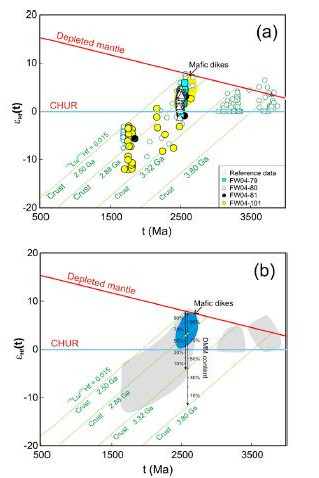Citation: Sun, J.F., Yang, J.H., Wu, F.Y., Wilde, S.A., 2012. Precambrian crustal evolution of the eastern North China Craton as revealed by U-Pb ages and Hf isotopes of detrital zircons from the Proterozoic Jing’eryu Formation. Precambrian Research, 200-203: 184-208.

Abstract: Simultaneous in situ U-Pb dating, trace element and Hf isotopic analyses have been carried out on detrital zircons obtained from sandstones in the Neoproterozoic Jing’eryu Formation from the Eastern block, North China Craton (NCC), with the aim of constraining the ages of magmatic and metamorphic events and Precambrian crustal evolution of the NCC. Two groups of zircons, i.e., magmatic and metamorphic in origin, have been identified based on cathodoluminescence images, zircon Ti-temperatures and Th/U ratios. Zircon U-Pb dating shows two main magmatic events with ages of 2.55-2.47 Ga and 1.80-1.70 Ga, and four metamorphic events, with ages of 2.51-2.48 Ga, 1.96-1.90 Ga, 1.87-1.85 Ga and ~1.80 Ga in the NCC. No zircon with an age more than 3.8 Ga has been identified in this study, indicating the limited presence of 3.8 Ga rocks in the NCC.
The Hf isotopic data show the ~2.5 Ga magmatic zircons have variable Hf(t) values with crustal model ages of 2.7-2.9 Ga, which can be interpreted to indicate mixed sources for their parental rocks, i.e., ancient crust (3.8 Ga or 3.3 Ga) and depleted mantle, implying significant continental crustal growth at ~2.5 Ga. However, Paleoproterozoic magmatic zircons all have negative εHf(t) and Archean Hf model ages, suggesting that their parental rocks were formed by recycled Archean materials.
The widespread ~2.5 Ga metamorphism in the Eastern Block, coupled with extensive ~2.5 Ga magmatism and crustal growth, are consistent with a mantle plume beneath the Eastern Block of the NCC during Neoarchean. whereas, belt-like ~1.85 Ga metamorphism, i.e., the increase of the metamorphic zircons with Paleoproterozoic ages from the Eastern Block to the Trans-North China orogen, is possibly explained by assembly between Eastern and Western Blocks at Paleoproterozoic.
